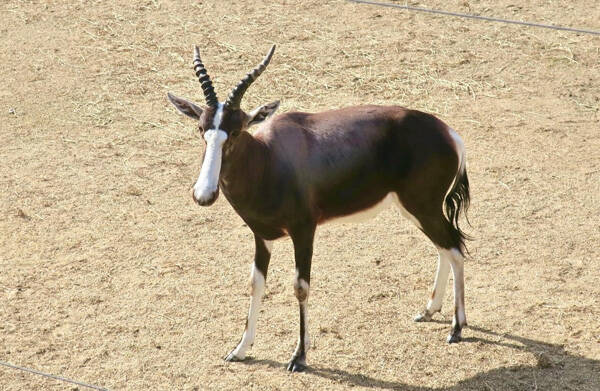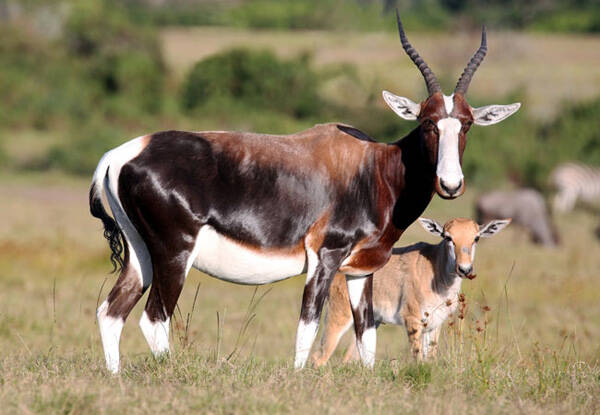Damaliscus pygargus
IUCN
LCBasic Information
Scientific classification
- name:Damaliscus pygargus
- Scientific Name:Damaliscus pygargus,Damaliscus pygargus pygargus,Damaliscus pygargus phillipsi
- Outline:Ungulata
- Family:Artiodactyla Bovidae Gnu
Vital signs
- length:140-160cm
- Weight:55-80kg
- lifetime:About 17 years
Feature
Not good at jumping, horns are harp-shaped and circular
Distribution and Habitat
Origin: South Africa.
Extinct: Lesotho.
Introduced: Botswana, Swaziland, Namibia and Zimbabwe.
The white-striped wildebeest is found in southern Africa. The nominate species is found in the highlands and coastal plains of South Africa, while the filipendula is found in eastern and central South Africa. The nominate species is more or less confined to protected areas in South Africa.
The nominate wildebeest is adapted to unique habitat and climatic conditions: the East Coast Renosterveld bioregion of South Africa receives rainfall all year round, but there is a distinct peak in winter, with about 65% of the rainfall between April and October. As a result, the subspecies has adapted for at least 20,000 years to a climate with wet and cold winters and warm and dry summers, which is the opposite of the conditions adapted to the filipendula, which prefers warm and wet summers and very cold but dry winters. The need for drinking water is essential, and during the dry season they
Appearance
The head and body of the white-lined wildebeest are 140-160 cm long, 80-100 cm tall at the shoulder, and the tail is between 30-45 cm long. Males are usually larger than females, with females weighing 55-70 kg and males weighing 65-80 kg. The body color is chocolate brown with a white lower abdomen and a white stripe from the forehead to the nose. Both sexes of both subspecies of the white-lined wildebeest have large, curved antelope-like horns that are harp-shaped and circular, and can reach more than 50 cm. The fur on the back is relatively dark, which contrasts with the white of the long legs and rump. The nominate subspecies is an average of 8 kg lighter than the pheasant subspecies, which helps to distinguish the two.
There are two subspecies, the nominate subspecies has purple-brown fur on the back, which is dark and shiny, and a white rump; while the pheasant subspecies has a dark reddish-brown back and dark fur on the rump.
White-lined wildebeest calves are born with ligh
Details
White-striped wildebeest (scientific name: Damaliscus pygargus) is also known as Blesbok in foreign languages. There are two subspecies.

Both subspecies of white-striped wildebeest are diurnal animals, mostly grazing in the morning and afternoon, and resting at noon and at night. They are social animals, with the nominate subspecies generally forming small groups of less than 10 individuals, while the fischeri subspecies forms groups of up to 25 individuals. The white-lined wildebeest are nomadic animals, migrating between seasonal pastures and forming large groups in the fall and winter. However, when they are settled in a large enough area, they continue to display semi-nomadic movement patterns, traveling in scattered groups throughout the range of the grasslands. The group structure is loose and the membership is unstable, but adult males defend the females and young in their group throughout the year. The white-lined wildebeest make a number of vocalizations used as alarm responses. Males mark and demarcate areas within their territories with defecation and dung piles. "Challenge rituals" are ritualized interactions between males in adjacent territories. Males also display dominance in a variety of postures and behaviors, including standing sideways in front of an intruder, digging with horns, stamping feet, and head bobbing. Fights between males are violent collisions with horns and can be fatal. Both males and females mark objects with secretions from the preorbital glands, which are deposited on grass stems when stroked with the horns.
Both subspecies of the white-striped wildebeest are herbivores, feeding primarily on short grasses found in grasslands. The forage of the subspecies fischeri includes red wild oats (Suga), but also eats grasses of the genera Teff and Chloromelas. The nominate subspecies feeds primarily on plants of the genera Bromus and Sedge, but also on plants of the genus Teff.

The white-striped wildebeest Filipino subspecies mates in February, while the nominate subspecies mates at peak in April. The gestation period for both is 8 months. Cubs are born between August and mid-December. Usually one cub is born per litter, and the cub can walk within 2 hours after birth. Lifespan is 17 years.
The species is abundant and not considered endangered. The nominate subspecies is abundant in formal protected areas and private protected lands. It is estimated that there are at least 54,426 mature individuals of the subspecies (with a 70% mature population structure) in 678 protected areas and wildlife ranches (counted between 2010 and 2016). The species has increased significantly in three generations (1990-2015) in formal protected areas throughout its range, and it is estimated that there has also been an increase in the number of white-striped wildebeest on private land. Other than hybridization, there are no major threats to the long-term survival of the white-striped wildebeest. The nominate subspecies has an estimated mature population of 752-1,618 individuals. The number of pure subspecies is unknown, as they occupy limited areas and their available habitat is decreasing.

The white-striped wildebeest is found in many state and private reserves in several provinces of South Africa. The subspecies of F. fischeri on private farms was able to reoccupy large areas of its original range, and large over-restricted populations of the subspecies have also been established on private land outside its natural range in South Africa and elsewhere. It is recommended that the protection of hybrid populations and restrictions on the movement of hybrids are key measures for the conservation of the subspecies. The white-striped wildebeest is a nominated subspecies, and its main protected areas include Agulhas National Park (a pure subspecies population in the natural range certified by the World Natural Heritage); Table Mountain National Park (a pure subspecies population in the benign introduction range certified by natural genetics); De Hoop Nature Reserve and Denel Overberg Test Range (the largest subspecies population in the natural range). A subspecies management plan covering all scattered subspecies is urgently needed.
Listed in the IUCN Red List of Threatened Species in 2017 ver 3.1 - Least Concern (LC).
The white-striped wildebeest is listed in the CITES Appendix II protected animals of the Washington Convention.
Protect wild animals and stop eating game.
Maintaining ecological balance is everyone's responsibility!








